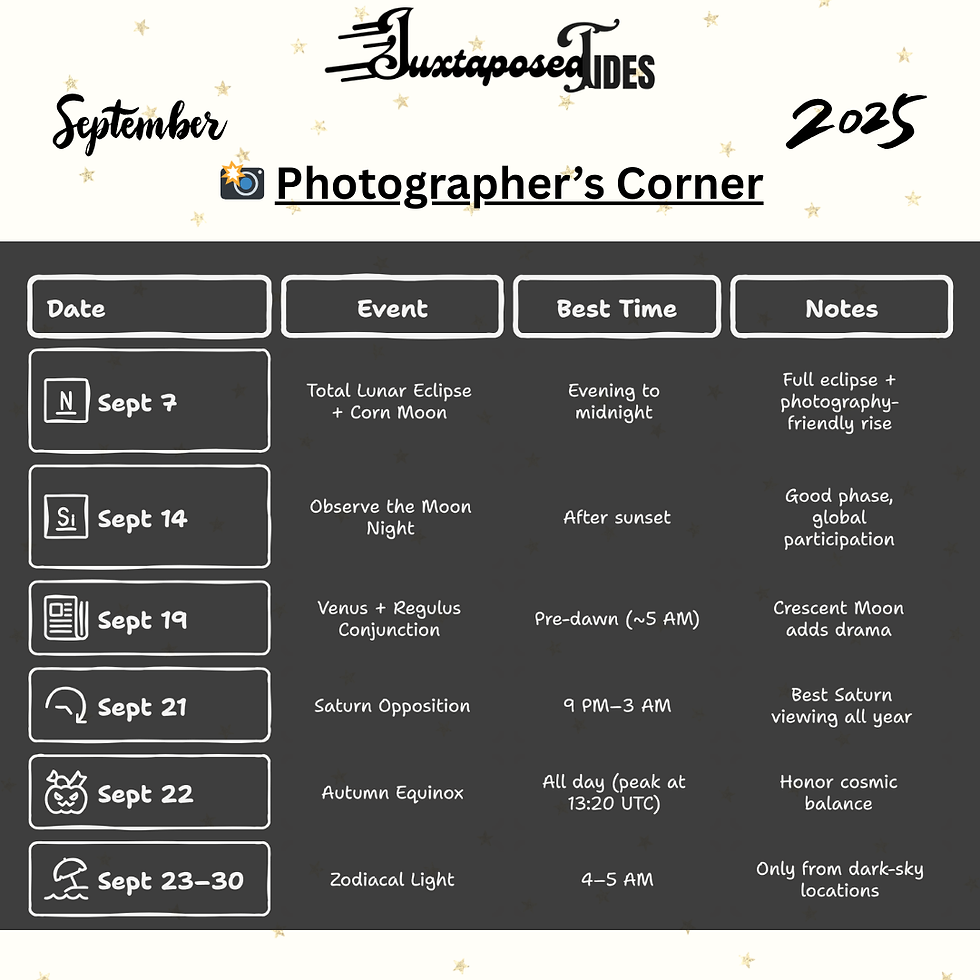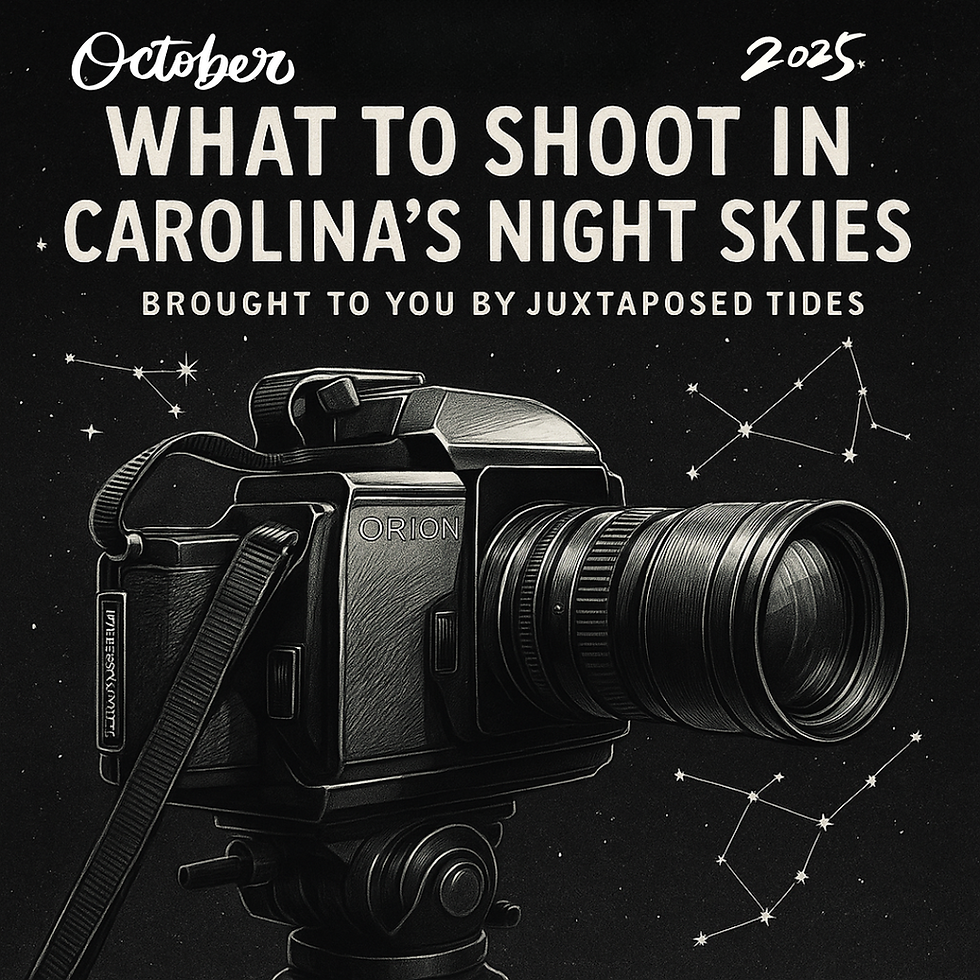JT What To Shoot In Carolina's Skies - September 2025 Edition
- Juxtaposed Tides

- Aug 31
- 5 min read
As summer exhales its final golden breath, the September sky opens a door to balance.
Daylight begins to slip beneath longer shadows. Nights stretch. And above us? A celestial theater packed with wonder.

This month brings a Blood Moon eclipse, a mighty Saturn opposition, poetic planet–moon embraces, and a shifting of seasons marked by equinox light. This is not the time to pack up your camera or retire your sky chart—it’s time to chase deeper, darker skies.
TL;DR – What’s in the Sky This September?
September 2025 is one of the richest sky-watching months of the year. A total lunar eclipse (Blood Moon) kicks things off on the night of the full Corn Moon (Sept 7), while Saturn reaches peak visibility during opposition (Sept 21). Early risers can catch Venus and Regulus in close conjunction with a crescent Moon (Sept 19), and dark-sky seekers may spot the elusive Zodiacal Light near month’s end. The autumn equinox (Sept 22) tips the balance between light and dark, reminding us to look up as the seasons shift. Don't miss these moments of cosmic poetry.
September’s Major Celestial Events – A Journey Through the Month
September 7 – Total Lunar Eclipse (Blood Moon + Corn Moon)
Just after nightfall on September 7, a rare and haunting sight will rise: a full Corn Moon that slips into the Earth’s shadow, becoming a Blood Moon visible across Europe, Africa, Asia, and Australia.
During totality, expect the Moon to turn shades of brick red and copper, as sunlight refracted by Earth’s atmosphere bathes it in eerie firelight.
Photographer’s Tip: Use a 200–600mm lens and low ISO. Mid-eclipse allows dramatic contrast between the dim moon and star-filled sky—bracket exposures to capture details.
September 7 – Full “Corn” Moon
Mark your calendars, folks! On September 7, 2025, the sky will be hosting the grand finale of summer's lunar trilogy in the Northern Hemisphere (or winter's in the Southern Hemisphere, because, you know, hemispheres like to keep things interesting). This celestial extravaganza is the third act in a series of full moons that have been strutting their stuff between the June 21 solstice and the September 22 equinox. While it might not be the headlining Harvest Moon, it will be putting on a show with some of those classic Harvest Moon moves. Speaking of the Harvest Moon, that superstar will be making its appearance overnight on October 6-7, 2025, in the Northern Hemisphere. Get your moon-gazing gear ready!
This year’s Corn Moon is the eclipse moon—a convergence of mythology and physics in one surreal show.
September 21 – Saturn at Opposition
The crown jewel of the solar system reaches its closest and brightest point of the year. At opposition, Earth passes directly between Saturn and the Sun, making the ringed giant visible all night long.
You don’t need a telescope to spot it—just look southeast after dark for a steady, golden light that doesn’t twinkle.
Fun Fact: Saturn’s rings are tilted ideally for viewing this year—offering more visible surface area than usual.
September 21 – Partial Solar Eclipse (Southern Skies Only)
While this one won’t be visible to Carolina viewers, southern hemisphere stargazers (especially in Antarctica, New Zealand, and the South Pacific) will witness a stunning crescent Sun. It also occurs just before the autumnal equinox—a celestial double-header.
September 22 – Autumnal Equinox
At exactly 13:20 UTC, the Sun crosses the celestial equator. Day and night split evenly across the planet. It’s the beginning of astronomical autumn in the Northern Hemisphere and a sacred balance point in Earth’s orbit.
Tradition: Ancient cultures like the Maya and Egyptians aligned monuments to equinox light. Today, it’s a perfect night to observe the symmetry in your own life.
Planetary Ballets + Moon Dances
September 19 – Venus + Regulus Conjunction
In the early dawn hours, watch as Venus, the brightest planet, slides closely past Regulus, the heart of Leo. On this morning, the crescent Moon, Venus, and Regulus form a celestial triangle glowing in the east.
Look around 5:00 AM local time. This one is poetry in motion—best viewed with the naked eye or wide-angle lens.
September 19 – Lunar Occultation of Venus
In parts of Europe, Africa, and Asia, the Moon will briefly swallow Venus—an occultation event where the planet is eclipsed behind the lunar disc. Not visible in the U.S., but still a cosmic alignment worth celebrating.
Pre-Dawn Planets
From early September through month’s end, keep your eyes eastward before sunrise.
There’s a planet party forming:
Venus—brightest and most obvious
Jupiter—rising higher
Mercury—low but visible with effort and binoculars
Try a planetary panorama before dawn—stack wide-angle photos for dreamy, soft-light captures of this celestial trio.
Bonus Celestial Moments
September 14 – International Observe the Moon Night
Join millions worldwide in gazing up at our oldest neighbor, the Moon, as it casts its silvery glow across the Earth. Whether from a city balcony overlooking the bustling streets below or from a serene mountain ridge where the air is crisp and clear, this is a night for reflection, outreach, and lunar love. As the Moon rises, it invites us to pause and contemplate not just its beauty, but also the vastness of the universe that surrounds us. It serves as a reminder of our shared humanity, as people from various cultures and backgrounds come together to admire the same celestial body that has inspired poets, scientists, and dreamers throughout history.
Local tip: Check with NC’s local observatories and stargazing groups. Many host public telescope nights.
Mid-September – Zodiacal Light Begins
Starting around September 18, the mysterious "false dawn" appears—an ethereal, pyramid-shaped glow caused by sunlight reflecting off interplanetary dust.
Look east before sunrise. You’ll need dark skies, minimal light pollution, and patience.
Photographer’s Challenge: Capture Zodiacal Light + the Milky Way. Try a 15-second exposure, ISO 3200+, f/2.8 or faster.
Your September Shooting Plan
Date | Event | Best Time | Notes |
Sept 7 | Total Lunar Eclipse + Corn Moon | Evening to midnight | Full eclipse + photography-friendly rise |
Sept 14 | Observe the Moon Night | After sunset | Good phase, global participation |
Sept 19 | Venus + Regulus Conjunction | Pre-dawn (~5 AM) | Crescent Moon adds drama |
Sept 21 | Saturn Opposition | 9 PM–3 AM | Best Saturn viewing all year |
Sept 22 | Autumn Equinox | All day (peak at 13:20 UTC) | Honor cosmic balance |
Sept 23–30 | Zodiacal Light | 4–5 AM | Only from dark-sky locations |
Stargazer’s September Pack
Don’t forget to:
Pack layers—it cools fast after equinox.
Use red light headlamps to preserve night vision.
Bring bug spray (the last wave before fall is always the worst!).
Use Stellarium, Sky Guide, SkyTonight or Heavens Above to plan your view.
Print your Juxtaposed Tides Stargazer's Resource Pack PDF (available here).
Share What You See
Every image, every sighting, every moment counts. Use hashtag #CarolinaNightSkies and tag @JuxtaposedTides on Instagram or Facebook for a chance to be featured in next month’s Photographer’s Corner.
September gives us the sky in balance—light meeting dark, night stretching longer, planets glowing brighter.
Let’s meet the moon. Let’s watch the sky tip. Let’s photograph the turning of the season.





Comments